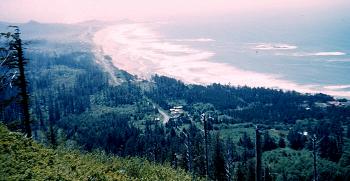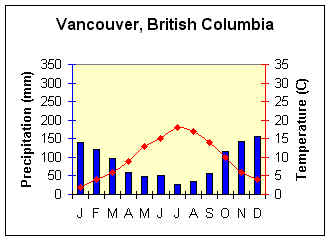
Figure \(\PageIndex{1}\): Coastal Oregon, USA (Source: NOAA)The marine or humid west slide climate is precisely what its name trace. This climate is found on the west coast of midlatitude continents and is very humid through most of the class. Its geographic placement places it in the path of westerly winds from the ocean that bring cloudy skies, much precipitation, and balmy temperatures. The distribution of the climate is greatly influenced by the orientation of mountain systems in North America and Europe .
Geographical Distribution
The marine west slide climate is found along a relatively minute strip of coastal Oregon, Washington, British Columbia, and southern Alaska in North America. It is similarly found along coastal Chile in South America. The marine west coast climate extends far inland into northwest Europe than in North America due to the orientation of mountains. This climate is besides found on the southeast slide of Australia and New Zealand .
Controlling Factors
The most significant control over the climate characteristics of the nautical west coast is its west coast localization in the midlatitudes. here maritime polar air masses are constantly coming ashore bringing meek temperatures and high humidity. In some cases like northern Europe, warm ocean currents moderate the temperature of the web site .
As noted above, the orientation of mountains has a large effect on the geographic distribution of the climate. In North and South America, mountains tend to be north-south oriented, whereas in Europe they tend to run more west to east. The north-south orientation acts as barrier to oceanic air masses in the Westerlies forcing them to rise and cool producing cloudy, showery conditions along the slide. In Europe, the oceanic air travel masses can penetrate promote inland, moderating the climate of a a lot larger region .
A significant dispute in the climate situations at Vancouver and London ( below ), both Marine West Coast climates, arises from location, local topography, and ocean current influence. The dry summer in Vancouver is due in part to subside, subtropical high pressure lying to the south. precipitation is closely double that of London due to local orographic uplift of air. Milder winter temperatures in London get up from the moderating determine of the North Atlantic Drift .

Figure \(\PageIndex{2}\): Climograph for Vancouver, British Columbia
Latitude/Longitude = 49.1oN ; 123.06oW
Average annual Temperature ( oC ) = 9.8
annual temperature Range ( oC ) =16
Total Annual Precipitation ( millimeter ) =1048
Summer Precipitation ( millimeter ) = 277
Winter Precipitation ( millimeter ) = 771

Figure \(\PageIndex{3}\): Climograph for London, England
Latitude/Longitude =51.3oN ; .07oW
Average annual Temperature ( oC ) = 10.4
annual temperature Range ( oC ) = 14
Total Annual Precipitation ( millimeter ) = 595
Summer Precipitation ( millimeter ) = 295
Winter Precipitation ( millimeter ) =300
Distinguishing Characteristics
Read more: Maritime search and rescue – Documentary
Temperature
The marine west coast is noted for its balmy summers and winters and, as a solution, a small annual temperature range. Its placement on the west seashore of a continent in the midlatitudes places the climate in the way of the Westerlies. In this situation, the climate receives a constant inflow of oceanic breeze throughout the class. The mild temperatures are a direct leave of the moderating influence of ocean bodies on air temperatures. The is particularly true for those situations where a warm ocean stream borders the continent, like the North Atlantic Drift ‘s consequence on northwestern Europe. temperature ranges increase as one moves away from the coast .
Precipitation
not only is the marine west coast noted for its meek temperatures but besides for its heavy defile overlay and gamey humidity through much of the year. This is specially true for the nautical west seashore climate of North America where orographic uplift is an crucial climate command. Maritime polar air masses forced to rise up the windward, western gradient make significant cloud shroud and precipitation. The marine west coast climate is dominated by cyclonic activity embedded in the Westerlies. Frequent cyclonic storms bring prolong periods of rain, drizzle and fog to these west seashore locations. In some locations it is not uncommon to receive a much as 2540 millimeter ( 100 in ) of haste in a year, an come that rivals the showery tropics .
